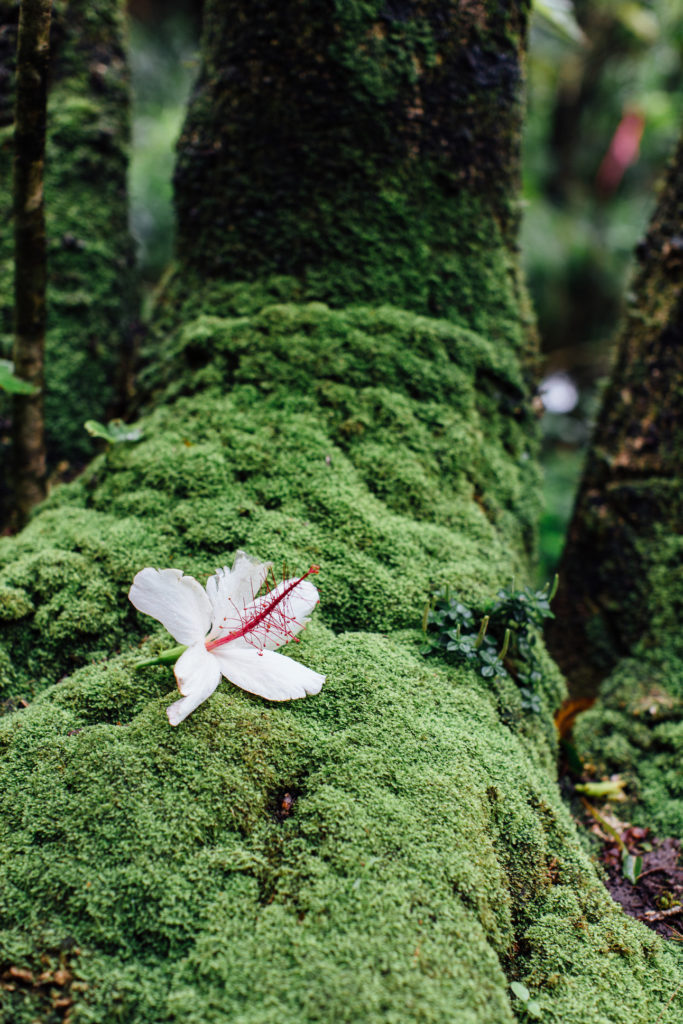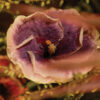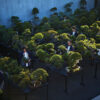Text by Michelle Broder Van Dyke
Images by Meagan Suzuki
Hiking Mānoa Cliff Trail on Pu‘u ‘Ōhi‘a, commonly known as Mount Tantalus, I am on a mission this summer morning to see a 33-foot-tall koki‘o ke‘oke‘o, an endemic white hibiscus tree. While hibiscuses are often bushes, this type of hibiscus grows to be a big tree, and the biggest one ever identified grows along this trail.
I walk through a thicket of invasive bamboo before entering a wet tropical forest populated by native ‘ōhi‘a ‘āhihi and smaller koki‘o ke‘oke‘o as well as alien ginger flowers and palm grass.
After 45 minutes, I reach the fence and gate at the edge of a restoration area maintained by volunteers with the Mānoa Cliff Restoration Project. Stepping inside, native plants abound; I feel like I’m entering a different time and place, as many of these plants are found nowhere else in the world.
The Mānoa Cliff Restoration Project was launched in 2005 after Mashuri Waite, a botanist who earned his doctorate from the University of Hawai‘i at Mānoa, received a state permit to work on restoring a six-acre portion of the native forest at the juncture of Mānoa Cliff Trail, Pu‘u ‘Ōhi‘a Trail, and Pauoa Flats Trail.
Waite, who is hiking barefoot in the mud when we meet at the restoration site, says he picked this spot because of the native plants still surviving here and because of its proximity to urban Honolulu. Every Sunday, at least a dozen volunteers gather on the mountain to pull alien weeds and cut down invasive trees in order to help the slower growing native plants flourish.
Walking through the area, there are dozens of koki‘o ke‘oke‘o, but Waite and Sebastian Marquez, a horticulturist who has been volunteering here since 2010, lead me directly to the biggest one of all.
This tree was nominated by a Hawai‘i resident and submitted to the National Register of Champion Trees, a competition started in 1940 by the nonprofit American Forests to locate the biggest tree—based on height, circumference, and crown spread—of each tree species in the United States.
Hawai‘i has been competing since 2011, and champions have been crowned for 18 of the state’s 21 eligible trees. Locals are encouraged to keep looking for champion trees among the elusive a‘e, wauke, and koki‘o ‘ula, a red hibiscus.
The white hibiscus tree looming before me has a thick, gnarly trunk brimming with endemic ferns, mosses, lichens, and bugs. It’s so large that it’s impossible to take it all in from one view. I find myself trying to delicately walk around it, as there are other native species planted in the understory. Its many outstretched branches spread up into the sky and blend into several adjacent hibiscus trees, forming a canopy 27 feet wide.
Like a temple, the tree invites us to gather beneath its high ceilings. According to Waite, records that were kept of the area starting in the 1950s show that this hibiscus is at least 70 years old. The flowers have delicate white petals and pink stamens, and they omit a subtle and sweet fragrance.
Sixteen years ago, when volunteers first started working in the area, the forest understory was thick with invasive plants, choking out much of the native flora, including these hibiscuses.
“In those early days, it was just a matter of weeding, weeding, and then coming across a native plant,” Marquez says.
The fence was installed in 2009 to keep feral pigs from digging up native ferns and hibiscus seedlings before they have a chance to grow strong. “Once you get some protection and some work, the plants will come back,” Marquez says. “You can make a difference.”

The hibiscus grows from seed, but to help it flourish, the volunteers also propagate hibiscus from the branches of older plants. While the hibiscus blooms year round, Waite says there is usually a “big pulse of flowers” that starts at the end of August.
“When they are in full flower, the canopies are just covered with white flowers. It’s dramatically different,” Marquez says of this late summer display.
“If you had a drone and flew up a couple hundred feet, you’d see this green forest full of white dots, and all of the white dots are hibiscus trees.”
Along with helping the hibiscus and the plethora of plants and bugs it hosts, the conservation work of the Mānoa Cliff Restoration Project ultimately helps all the native plants and animals in the forest.
“Once we get the canopy and ferns established, we’ll see more native plants coming up,” Marquez says.
Using historical records, volunteers have also identified and planted native flora that had vanished from the area, like the koki‘o ‘ula. Today the reserve is home to as many as 125 native plant species.
Every Sunday, volunteers are encouraged by rare endemic honeycreeper birds, like the crimson ‘apapane and yellow-green ‘amakihi, singing in the trees. “We’ve seen how our actions have made a benefit for these plants, so it’s nice to think maybe that’s why ‘amakihi and ‘apapane are here,” Marquez says. “We hear them all the time.”







